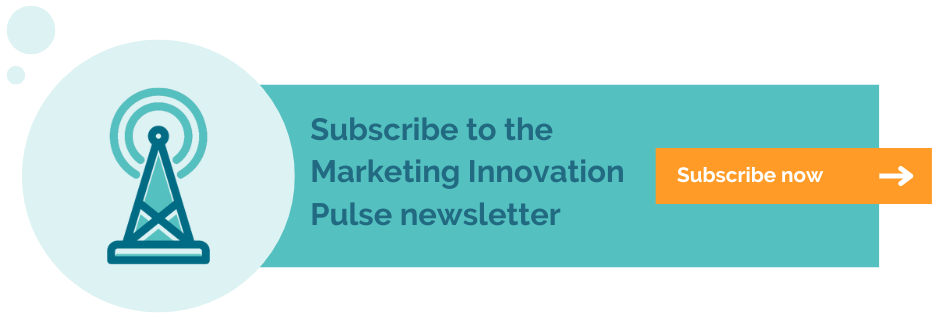
The latest edition of Aira’s innovation update is here! Fortunately, it’s really not hard to come up with things to talk about.
Again, we’ve got a quick summary of some of the stuff we’ve been reading recently, some updates of what we’ve been doing at Aira, and this time some details on some of the ways our Consultants have been using new tools.

What we’ve been reading
To be honest, we’re finding it hard to cut down our reading list for these updates, but here’s a selection of interesting pieces on some different topics:
- Recast did a great quick-read on how companies of different sizes/stages of growth should think about attribution. Honestly, for a Mixed Media Modelling tool company, it’s pretty impressive that Recast dedicates so much time to telling people when they might not need MMM.
- YouGov released a whitepaper about how consumers are responding to the cost-of-living crisis. They cover 13 countries but with a particular focus on the UK and US. Some interesting stats in there but, as with anything survey-based, it’s worth bearing in mind the data can be skewed by who happened to respond.
- Google have created a Machine Learning model that can take an item of clothing and show how it would look on different body types. While this is cool, we imagine that most clothing companies will want more control over the way customers see their clothes than simply relying on Google correctly guessing what designers changed between sizes.
- McKinsey think that AI is going to add 4.4 trillion to the global economy, but only as long as we make sure people are supported as they adapt roles/change jobs (this is not a short read)
What we’ve been doing
- We shared an internal tool we’ve been using to reformat tables to be presentable (this kind of unexciting work is exactly the kind of thing we want to take off consultants’ plates)
- We hosted our first HubSpot User Group in June, with a range of talks on AI. External speaker Claudia Higgins from Conductor spoke about the state of AI in SEO and was followed up by Aira’s very own David Westby who looked at AI, Google and Accountability with a keen focus on the changes being implemented by the search engine and the potential ramifications for businesses. Matthew Purchase, also from Aira, delivered a talk on a brief history of AI and HubSpot, looking at the existing AI features within the platform, the recent acquisitions ,and speculated on where this could go.
- We announced the return of MKGO for this September, with free tickets currently available here. The event will be held at Milton Keynes Gallery, and we've got some great speakers lined up, including Azeem Ahmad, Mehul Garg and our very own Katherine Monkcom, so what are you waiting for? Grab your free ticket before they run out!
What we’ve been thinking - Everyone is innovating
At Aira we believe pretty strongly that innovation shouldn’t just come from the ‘Innovation’ team - they should come from the people working directly on client problems. People who are getting daily exposure to what our clients need. It’s the same reason our Consultants are the ones who wrote up their perspective on how Google’s adoption of AI is likely to change the search landscape.
In this update we wanted to share some stories about how our Consultants are using tools like ChatGPT to supercharge their day-to-day work.
Building two image compression tools using ChatGPT - Mathew Stuckey
I recently did some work for a client which required compressing a large amount of their image catalogue in a bid to improve load times.
After becoming frustrated with the constant back and forth due to the file limits imposed by web-based tools, I decided to look into creating my own image compression tool via ChatGPT which I could run through codepen.io (check it out here!).
Initially, I’d simply asked if it could “code me an image compression tool”, which obviously it told me it could do easily, and then gave me a code script that didn’t function in the slightest.
I spent a lot of time chatting with GPT, simply telling it that the tool didn’t work listening to its apologies and then retrying with the next line of code it gave me. Eventually I gave up.
But the next day, after hitting another file limit on a free tool, I revisited the idea. After some reading up on image compression and GPT prompting, I eventually came up with the following prompt;
“You are a high-end developer with substantial knowledge of coding and image compression techniques.
I would like you to give me the individual HTML, CSS and Javascript code for an image compression tool. The tool should be able to handle both JPEG and WEBP files.
It should allow for multiple files to be uploaded at once up to a limit of 20.
The tool will then compress those files using lossy compression for the webp and jpeg at a rate of 0.3.
The tool should have a progress bar so that the user can see the status of the compression job.
The output should be a list, so that the user can redownload the individual files as they need.
The tool should be styled in a simple, modern way and be easy to navigate for users.”
This gave me a MUCH better looking output which, after copying into Codepen, still didn’t work at all.
But it was far closer.
One of the benefits of using a tool like Codepen is it allowed me to have a back and forth with GPT by just presenting it with any errors that were shown in the console box, it was then able to assess the error and adjust the code accordingly.
In fact, after copy and pasting the single error that was thrown up this time around, GPT was able to debug its own code and promptly provided me with an amended version of the Javascript.
Once this code was swapped over, success! I now had a fully functional compression tool that would allow me to compress client images without any intrusive ads, usage limits or requirements to upgrade to a pro version.
The success of this made me look into other tools I could also create using the power of GPT. So, I also put together a similar WEBP conversion tool which can take multiple image files and convert them all into WEBP format, with the output being an automatically downloaded .zip file of the new images.
Where tools like Convertio only allow for two conversions at a time, I can now transfer an entire image catalogue in one go and convert a client's images to a faster format in one click. This saves a huge amount of time and effort, meaning I have more time to focus on work elsewhere.
Categorising content using ChatGPT - Kathryn Monkcom
Like my colleagues, I’ve been spending some time investigating ways in which ChatGPT can help us do better work, faster. Of course, we don’t always just assume these tools are the best ones for the job and ,in this case, GPT isn’t ready to fly solo, but there’s a couple of things we can do now.
When it comes to inbound strategy, planning concepts for gated content can be one of the more time-consuming tasks. It often comes down to:
- Research what’s already out there
- Come up with some new ideas and choose one
- Test how it performs
- Repeat
A good way to narrow down your options is to try to find examples of high traffic content that not many people have covered. And the best way to do that is to scrape as many websites as possible in your niche, categorise the content and see what’s getting a lot of traffic, but doesn’t seem to be covered in much detail.
I wanted to see if GPT could help us speed up the categorisation step. I found that I had to do a lot of manual cleanup on the output, so I don’t think it’s quite ready to do everything yet. I ended up using GPT as a first pass, followed by some trusty RegEx and then my own manual checking.
Here’s my process to give you a head start so you can come to your own conclusions - or come up with something better!
- I used Ahrefs to scrape my client’s site, and their competitors, getting monthly traffic and a title for each page
- I used GPT for Sheets™ and Docs™ to group the pages into one of: Checklist, Guide, Resource, Ebook, Template, Other. You could also use it to group by topic or theme, i.e. ‘Marketing Automation’ or ‘Strategy’.
- I then used sheet regex formulas over the same page titles to put together flexible categories based on the same terms. This was a great way to sense-check/overrule GPT categories.
- For each group I counted up the traffic, and the total number of pages, to find categories where there was lots of traffic but not that many pages.
By looking at traffic numbers and page count I could quickly see that Checklists were one of the best performing but least used formats. My client had been focusing all their time on guides, which performed well but had a lot of competition. This was great insight that helped us plan our next few months of highly effective content.
As I mentioned, GPT didn’t do a great job of categorising the pages alone. It seemed to rely a lot on exact word match. For now - RegEx is more reliable but I did get some help from our GPT-based “make me a formula” tool to speed that up, so there was still some value to be had there!
The next thing we’re going to try is scraping the sites further to get page content and check them for related words or phrases. With that extra information, GPT may well take the lead!
Prompt engineering to help with SEO tasks - Matthew Kohli
I am a well-known ChatGPT-enthusiast at Aira and I’ve spent quite a lot of time looking for ways to use the tool to improve our work. For example, our copy briefing process.
Aira’s copy briefing process goes something like this;
- SEO Strategist does keyword research, competitor analysis, and client interviews to understand the industry
- SEO Strategist turns that research into a detailed brief (with recommended structure and titles)
- An expert copywriter (normally expert in both copywriting and the client industry) writes the content.
In my experience, GPT can’t do steps 1 or 3. It gets facts wrong, doesn’t have the depth of a good copywriter, and doesn’t care about business impact (not to mention all the industry context it is missing). However, it is pretty great at rewriting or restructuring information, so it can speed up step 2 by a lot.
Here’s the process I use:
First, complete your research (kind of goes without saying) then download “LinkReader” and “Webflow” ChatGPT plugins. Finally, use this prompt structure:
“Please help me create a comprehensive article heading structure for my client X (client URL). The primary keyword and topic for this article is "X"
The client does X
Their main target audience is X
Their TOV is X, see the following example for reference:
Example text, example text, example text etc
Their main competitors are:
Competitor 1
Competitor 2
Competitor 3
Competitor 4
Competitor 5
Their USP vs the competition is X
Supporting keywords to target are:
Keyword 1
Keyword 2
Keyword 3
We want to internally link to the following articles. They do not need their own headers, just provide suggestions for where it would be relevant to link to them:
Internal product/service page URL - this is a relevant product/service that we want to encourage users to engage with
Internal blog URL - this is a supporting article
Internal blog URL - this is a supporting article
Internal blog URL - this is a supporting article
The top 5 ranking pages for the primary keyword X are:
URL 1
URL 2
URL 3
URL 4
URL 5
We want to create something that is comprehensive and engaging to outperform the current articles on page 1. Give me a heading structure in a table format please, with two columns. In the first column on the left I need the heading level (h1,h2,h3) and the heading title together, then in the right column I would like a brief explainer for the writer.
Separate from the heading structure table, please provide an engaging meta description in less than 155 characters, thank you.”
I’ve included an example of using this prompt for Aira, and the results, at the end of this post.
Of course, the final step is to review the results, make sure they line up with your expectations, and to coordinate with your copywriter.
Hope this saves you some time!
Example prompt for “Internal Linking For SEO: Comprehensive Guide” for Aira:
Please help me create a comprehensive article heading structure for my client Aira Digital (https://aira.net/). The primary keyword and topic for this article is "internal linking" and the article title should be “Internal Linking For SEO: Comprehensive Guide”.
The client is a Digital Performance Marketing Agency that specialises in SEO, PPC, Inbound Marketing, Content Marketing, and Account-based Marketing
Their main target audience is companies looking for digital marketing support for their business
Their TOV is friendly and professional, see the following example for reference:
“Anyone can promise you traffic. Aira grows your businesses with multi-channel digital marketing that's measured in sales and revenue.”
Their main competitors are:
https://www.impressiondigital.com/
https://withcandour.co.uk/
https://www.brainlabsdigital.com/
https://www.seoworks.co.uk/
https://www.bluearray.co.uk/
Their USP vs the competition is:: “The best people. Because you need specialists who can communicate as well as they implement. A plan is only as good as the people who execute it. And a poor experience cancels out a great result. So we invest in people who get that. Everyone on your account will know your name, take ownership without ego, and come to you proactively with ideas, updates, and opportunities.”
Supporting keywords to target are:
- Internal linking for seo
- Internal linking best practices
- seo internal linking
- internal link strategy
Provide suggestions for where we should include the internal links under the relevant headings, we want to make it as clear as possible for our copywriters. We want to internally link to the following articles:
- https://aira.net/seo/ - this is a relevant product/service that we want to encourage users to engage with
- https://aira.net/blog/sudden-drop-in-website-traffic/ - this is a supporting article
- Ihttps://aira.net/blog/what-factors-and-attributes-are-most-important-to-consider-in-your-link-building-strategy/ - this is a supporting article
- https://aira.net/blog/how-ai-is-set-to-dramatically-change-performance-marketing/ - this is a supporting article
The top 5 ranking pages for the primary keyword X are:
- https://yoast.com/internal-linking-for-seo-why-and-how/
- https://moz.com/learn/seo/internal-link
- https://backlinko.com/hub/seo/internal-links
- https://www.semrush.com/blog/internal-links-guide-to-building-strategy-that-works/
- https://ahrefs.com/blog/internal-links-for-seo/
We want to create something that is comprehensive and engaging to outperform the current articles on page 1. Give me a heading structure in a table format please, with two columns. In the first column on the left I need the heading level (h1,h2,h3) and the heading title together, then in the right column I would like a brief explainer for the writer.
Separate from the heading structure table, please provide an engaging meta description in less than 155 characters, thank you.
Here’s the output:
Meta Description: "Boost your SEO with our comprehensive guide on internal linking. Learn the basics, best practices, and strategies to improve your site's performance."
| Heading level and title | Brief explainer for the writer |
| H1: Internal Linking For SEO: Comprehensive Guide | This is the main title of the article. It should introduce the topic and grab the reader's attention. |
| H2: Understanding the Basics of Internal Linking | Explain what internal linking is, why it's important, and how it impacts SEO. |
| H3: What is Internal Linking? | Define internal linking in a simple, easy-to-understand way. |
| H3: The Importance of Internal Linking for SEO | Discuss the benefits of internal linking for SEO, including site navigation, spreading link equity, and improving page authority. |
| H2: Internal Linking Best Practices | Provide a detailed guide on how to effectively implement internal linking strategies. |
| H3: Using Anchor Text Effectively | Discuss the importance of anchor text in internal linking and provide tips on how to choose the right anchor text. |
| H3: Balancing Link Value | Explain how to balance the distribution of link value across the website. |
| H3: Creating a User-Friendly Link Structure | Discuss how to create a link structure that enhances user experience and boosts SEO. |
| H2: Developing an Effective Internal Link Strategy | Provide a step-by-step guide on how to develop an effective internal link strategy. |
| H3: Conducting an Internal Link Audit | Discuss how to conduct an internal link audit and why it's important. |
| H3: Identifying Opportunities for Internal Links | Provide tips on how to identify opportunities for internal links within the website. |
| H3: Implementing the Internal Link Strategy | Discuss how to implement the internal link strategy, including adding new links and updating existing ones. |
| H2: Case Study: Successful Internal Linking in Action | Provide a case study or example of a successful internal linking strategy. This could be a client success story or a well-known example in the industry. |
| H2: Common Mistakes to Avoid in Internal Linking | Discuss common mistakes in internal linking and provide tips on how to avoid them. |
| H2: Conclusion: The Power of Internal Linking for SEO | Wrap up the article by reinforcing the importance of internal linking for SEO and encouraging the reader to implement the strategies discussed. |
If you have any questions about the topics we've covered in this month's Pulse, don't hesitate to get in touch.






